How To Make Your Own Microscope Stain
Amateur microscopy is a low-cost way for students and science enthusiasts to observe the world in miniature. With an inexpensive consumer-grade compound microscope and a handful of cheap slides, you can embark on a journey of scientific exploration that begins in your own backyard. Stain your specimens to increase contrast and exhibit more detail under the microscope. Though commercial stains are available for purchase from scientific supply stores, you may make your own microscope stains at home using easily obtained dyes and a scientific process of trial and error.
Step 1
Choose your dye. Common household dyes include red or blue food coloring, iodine or India ink. You may also obtain methylene blue or malachite green dye from the aquarium section of a pet supply store.
Step 2
Dilute the dye with distilled water. The optimal dilution rate will vary depending on the strength and type of your dye, as well as the object to be stained. To begin, use a 1:1 dilution ratio of dye solution to water.
Step 3
Mount your specimen on a glass slide. For a simple wet mount, apply a drop of water to the slide and carefully place the specimen on the wet portion.
Step 4
Apply a few drops of diluted dye to the sample. Keep the dye and the samples in contact for one to three hours to allow time for dye absorption. Rinse the dye from the sample using an eyedropper full of distilled water. Place the coverslip on top and examine the slide under the microscope.
Step 5
Adjust the dye formulation through trial and error. If the dyeing is unsatisfactory, add a few drops of vinegar to the solution to make the pH more acidic. Experiment with higher concentrations of dye. Use multiple dyes in the same solution to achieve a different staining effect.
Things Needed
- Food coloring or other dye
- Distilled water
- Eyedropper
- Vinegar
- Glass slides
- Glass or plastic coverslips
- Compound microscope
TL;DR (Too Long; Didn't Read)
Homemade dyes also work with more complicated mounting techniques, such as fixatives and dry mounts. Mount your slides according to your usual process, substituting the homemade solution for your normal dye.
Cite This Article
MLA
MacIntosh, Mary. "How To Make Your Own Microscope Stain" sciencing.com, https://www.sciencing.com/make-own-microscope-stain-12034422/. 24 April 2017.
APA
MacIntosh, Mary. (2017, April 24). How To Make Your Own Microscope Stain. sciencing.com. Retrieved from https://www.sciencing.com/make-own-microscope-stain-12034422/
Chicago
MacIntosh, Mary. How To Make Your Own Microscope Stain last modified March 24, 2022. https://www.sciencing.com/make-own-microscope-stain-12034422/
